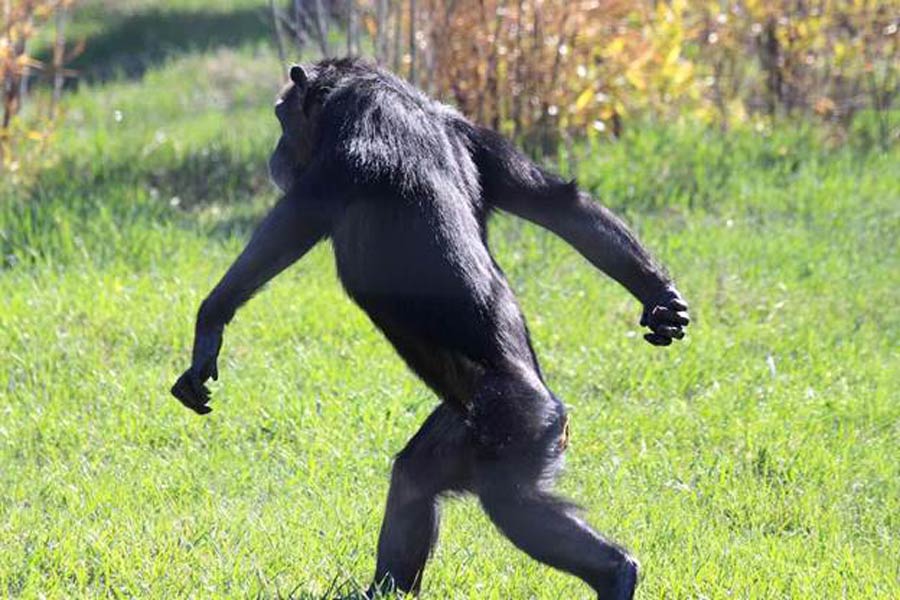Decades Of Incorrect ‘Stride’ Assumptions Have Been Debunked
For many years evolutionary scientists have taught that early humans evolved ‘longer’ strides than other primates. It turns out this was a highly-inaccurate assumption. A new study on chimpanzees shows the human stride is relatively ‘much shorter’ than all of our primate cousins, and it also reveals insights about why we walk as we do.
Eradicating False Assumptions One Step At A Time
The challenged paradigm is that the “long” human stride developed for efficiency. This is “taught in almost every introductory class and textbook,” says Nathan Thompson from the New York Institute of Technology, USA. In his new paper published in The Journal of Experimental Biology the researcher suggests that after about 7 million years of selective pressure for economical bipedalism, “there has been a lot of time to experiment with the costs and benefits.”
Compared with the strides of our closest primate relatives, “even the tallest humans take relatively short steps,” wrote Thompson. He added that when standardized by size, in comparison with other primates, humans don’t really have long strides at all. Having cleared this traditional myth surrounding the assumed grandiosity of the human stride, Thompson says it might have been worthwhile for early humans to have walked with slightly shorter strides. For, whatever energy we lose, said the scientist, “we might make up elsewhere.”
- Ancient Crocodiles Walked On Two Legs Like Dinosaurs
- Our Ancestors Should Have Avoided Parathropus Boisei – They Gave Us Genital Herpes

The human stride is relatively not as long as a chimpanzee, although our legs are of course longer. (SHOTPRIME STUDIO / Adobe Stock)
Turning Organic Strides Into Big Data
The traditional misconception about humans having large steps became clear to Thompson when he began investigating the rotational movements in chimpanzee pelvises. Watching them walk, he began wondering whether the distinctive swivelling action observed in chimp’s hips might be related to why they have longer relative strides than humans.
The professor’s experiment first required teaching chimpanzees to walk upright on two feet while being filmed with high resolution 3-D cameras. Researchers Danielle Rubinstein, William Parrella-O ’Donnell and Matt Brett reconstructed human stride patterns and hip motions, that were also recorded in 3-D. Then, the humans’ steps were scaled down to overlay on the chimpanzees. This showed that while the human ‘legs were proportionally “112% longer, their strides were 26.7% shorter,” than those of chimpanzees.
It was also observed that chimpanzees swiveled their hips between “28 and 61 degrees” while human hips only rotated their hips by a mere 8 degrees.
The results of this comparative analysis on walking speed and time revealed chimp strides are “25% longer than humans.” This means chimp strides are “5.4 times” greater than what are in comparison mini “side to side wiggles” performed by humans when they walk.
- Evidence Suggests Human Ancestor Walked Upright In Trees
- Did Supernovae Inspire Our Hominin Ancestors to Walk Upright?
What Does All This Mean For Science? And For My Strut?
Thompson concluded that chimpanzees probably developed pelvic rotations “to squeeze every bit of stride length out,” or their relatively short legs. And attempting to answer why humans don’t have the same swiveling motion in their hips as chimps, Thompson suggested the extreme rotations of the hips was all about achieving balance. He wrote that chimps swing their arms and legs to serve as a kind of counterbalancing system, a sort of weight displacement mechanism. The scientist wrote that by forcing their muscles to work harder, even while the human stride was less efficient, this was “a price that simply might not be worth paying for an increased stride length”.
So there we have it folks. Decades of wrong assumptions about the size of the human step have now been put right. No longer will our grandchildren be taught that humans have a large stride, but they will now learn that the relatively short human stride evolved not for size, but for efficiency. However, if a child were to ask Thompson, “sir, surely environmental factors greatly affected the human stride,” the researcher would no doubt say what he wrote in his paper, that many other factors also impacted the development of our strides, and the ways in which we all walk today.
Top image: Chimpanzees walking on two legs has a pelvic swivel far larger than humans, increasing their stride. Source: Chimpanzee Sanctuary Northwest
By Ashley Cowie



















